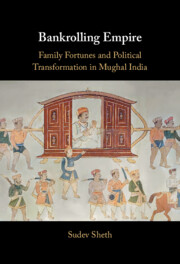159 results
Chapter 44 - Economics
- from Part VI - Social and Intellectual Topics
-
-
- Book:
- Jonathan Swift in Context
- Published online:
- 02 May 2024
- Print publication:
- 09 May 2024, pp 350-357
-
- Chapter
- Export citation
Chapter 23 - Wagner’s Finances
- from IV - Life, Language, and the Ancient World
-
-
- Book:
- Wagner in Context
- Published online:
- 14 March 2024
- Print publication:
- 14 March 2024, pp 229-238
-
- Chapter
- Export citation
5 - Money, Credit and Banking, 1000–1500
- from Section II - The Medieval Economy, 1000–1500
-
-
- Book:
- An Economic History of the Iberian Peninsula, 700–2000
- Published online:
- 22 February 2024
- Print publication:
- 29 February 2024, pp 130-157
-
- Chapter
- Export citation
Chapter 1 - Counterfeit Money
-
- Book:
- The Theology of Debt in Late Medieval English Literature
- Published online:
- 04 January 2024
- Print publication:
- 18 January 2024, pp 25-49
-
- Chapter
-
- You have access
- HTML
- Export citation
The Currency of Politics: Rejoinder
-
- Journal:
- European Law Open / Volume 2 / Issue 3 / September 2023
- Published online by Cambridge University Press:
- 10 January 2024, pp. 671-691
-
- Article
-
- You have access
- Open access
- HTML
- Export citation
Introduction
-
- Book:
- Bankrolling Empire
- Published online:
- 16 November 2023
- Print publication:
- 30 November 2023, pp 1-42
-
- Chapter
- Export citation
5 - Expedient Extortion: The Governor’s Golden Goose Khushalchand Jhaveri, 1719–30
-
- Book:
- Bankrolling Empire
- Published online:
- 16 November 2023
- Print publication:
- 30 November 2023, pp 177-222
-
- Chapter
- Export citation
1 - Prelude: The Mughal Empire, 1526–1750
-
- Book:
- Bankrolling Empire
- Published online:
- 16 November 2023
- Print publication:
- 30 November 2023, pp 43-70
-
- Chapter
-
- You have access
- HTML
- Export citation

Bankrolling Empire
- Family Fortunes and Political Transformation in Mughal India
-
- Published online:
- 16 November 2023
- Print publication:
- 30 November 2023
Art and money: Three aesthetic strategies in an age of financialisation
-
- Journal:
- Finance and Society / Volume 1 / Issue 1 / 2015
- Published online by Cambridge University Press:
- 09 November 2023, pp. 38-60
-
- Article
-
- You have access
- Open access
- Export citation
Hard cash, easy credit, fictitious capital: Critical reflections on money as a fetishised social relation
-
- Journal:
- Finance and Society / Volume 1 / Issue 1 / 2015
- Published online by Cambridge University Press:
- 09 November 2023, pp. 20-37
-
- Article
-
- You have access
- Open access
- Export citation
Bitcoin and stone money: Anglophone use of Yapese economic cultures, 1910-2020
-
- Journal:
- Finance and Society / Volume 8 / Issue 1 / 2022
- Published online by Cambridge University Press:
- 09 November 2023, pp. 42-66
-
- Article
-
- You have access
- Open access
- Export citation
Making ‘Making money’: A discussion with Ole Bjerg
-
- Journal:
- Finance and Society / Volume 1 / Issue 1 / 2015
- Published online by Cambridge University Press:
- 09 November 2023, pp. 75-80
-
- Article
-
- You have access
- Open access
- Export citation
The time of money in finance and US society
-
- Journal:
- Finance and Society / Volume 4 / Issue 1 / 2018
- Published online by Cambridge University Press:
- 09 November 2023, pp. 15-25
-
- Article
-
- You have access
- Open access
- Export citation
Is there life after debt? Revolution in the age of financial capitalism
-
- Journal:
- Finance and Society / Volume 1 / Issue 1 / 2015
- Published online by Cambridge University Press:
- 09 November 2023, pp. 81-89
-
- Article
-
- You have access
- Open access
- Export citation
Where has all the money gone? Materiality, mobility, and nothingness
-
- Journal:
- Finance and Society / Volume 1 / Issue 1 / 2015
- Published online by Cambridge University Press:
- 09 November 2023, pp. 7-19
-
- Article
-
- You have access
- Open access
- Export citation
World monies or money-worlds: A new perspective on cryptocurrencies and their moneyness
-
- Journal:
- Finance and Society / Volume 7 / Issue 2 / 2021
- Published online by Cambridge University Press:
- 09 November 2023, pp. 130-139
-
- Article
-
- You have access
- Open access
- Export citation
Chapter 8 - Fitzgerald’s Nonfiction
-
-
- Book:
- The Cambridge Companion to F. Scott Fitzgerald
- Published online:
- 26 October 2023
- Print publication:
- 09 November 2023, pp 177-202
-
- Chapter
- Export citation
Money as a computational machine
-
- Journal:
- Finance and Society / Volume 8 / Issue 2 / 2022
- Published online by Cambridge University Press:
- 09 November 2023, pp. 110-128
-
- Article
-
- You have access
- Open access
- Export citation
5 - Social Class, Neighborhoods, and Romantic Relationships
-
-
- Book:
- The Sociocultural Context of Romantic Relationships
- Published online:
- 19 October 2023
- Print publication:
- 02 November 2023, pp 71-89
-
- Chapter
- Export citation



